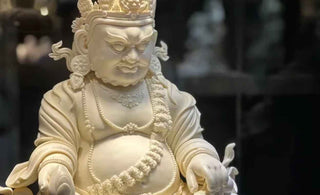
The artistry of Tibetan statues, steeped in ancient traditions, unravels a fascinating tale when one delves into the intricate technique of their creation – the Lost Wax Method. This age-old method, where wax becomes both a mold and a sacrifice, carries within it the echoes of countless artisans who have meticulously crafted these divine embodiments through the corridors of time.
At the heart of the Lost Wax Method lies a process that is both mystical and methodical. Artisans begin by sculpting the envisioned deity or figure with precision and dedication. The chosen material, often a malleable wax, becomes a temporary vessel for the spiritual essence that is about to be immortalized. This initial wax model, embodying the divine form, serves as the blueprint for what will later emerge as a transcendent statue.
Once the wax model is perfected, a clay mold is carefully fashioned around it, creating a protective cocoon that will later bear the molten metal. The meticulousness of this stage is crucial, for it is here that the intricate details, the very soul of the statue, are transferred onto the mold. The process mirrors the spiritual journey it represents – a delicate dance between form and formlessness.
The wax, now encased in clay, undergoes a profound transformation. Heat becomes the alchemical catalyst, melting the wax away and leaving behind a cavity that mirrors the sculpted deity. This hollow space, akin to the sacred emptiness sought in spiritual practice, is a symbolic void waiting to be filled with the molten essence of divinity.
Consider the "Five Wisdom Tathagatas Tibetan Colored Glass Statue," a masterpiece crafted through the intricate Lost Wax Method. As artisans meticulously sculpt the initial wax model, they channel the wisdom of the Tathagatas, creating a vessel that embodies the quintessence of enlightenment. The wax, a transient placeholder for the divine, symbolizes the impermanence of the material world. Encased in a clay mold, the wax model serves as a conduit for the transformative alchemy that is to follow. When the molten glass, chosen for its ethereal translucency, is poured into the waiting mold, it becomes the medium through which the wisdom of the Tathagatas takes tangible form. The glass, embodying the molten essence of divinity, fills the void left by the wax, creating a luminous and transcendent statue. The sacred emptiness, now illuminated by the radiant hues of colored glass, becomes a visual representation of the enlightened wisdom that transcends the illusions of duality. The "Five Wisdom Tathagatas Tibetan Colored Glass Statue" stands not only as a testament to the profound craftsmanship of the Lost Wax Method but also as a tangible embodiment of the sacred teachings woven into its very form. As light passes through the glass, it refracts and dances with the nuances of enlightenment, inviting those who behold it to contemplate the interconnectedness of form and emptiness, material and spiritual.
The choice of metal is as pivotal as the sculpting itself. Copper, bronze, or other sacred alloys are heated to a liquid state, embodying the transformative power of fire that pervades religious symbolism. The molten metal, poured into the waiting mold, rushes to occupy the space left by the now-vanished wax. The meeting of liquid metal and void symbolizes the union of form and emptiness, a central tenet in Buddhist philosophy.
The artisan's role becomes a profound act of devotion as they guide the molten metal into the intricacies of the mold. The success of this stage hinges on a delicate balance of temperature, timing, and the artisan's mastery. The metal, in its molten state, not only fills the void left by the wax but also absorbs the spiritual imprints embedded in the original sculpting.
As the metal cools and solidifies, the clay mold is broken away, unveiling the newly formed statue—a materialized deity infused with the essence of the divine. The rawness of the freshly cast statue mirrors the unfiltered nature of enlightenment, embodying the inherent purity obscured by the illusions of the material world.
The Lost Wax Method, with its ancient roots in Tibetan culture, transcends mere craftsmanship. It is a sacred ritual, a transformative journey that mirrors the spiritual path itself. The wax, once a malleable medium, becomes a sacrificial offering, symbolizing the impermanence inherent in all things. The molten metal, like the alchemical elixir, imparts divine permanence to the ephemeral form.
This technique not only preserves the artistic legacy of Tibetan culture but also encapsulates the spiritual ethos of people devoted to expressing the ineffable through tangible art. The resulting statues, whether depicting Buddhas, Bodhisattvas, or other revered figures, become more than mere objects—they become conduits of the sacred, resonating with the spiritual aspirations of both creator and beholder.
In essence, the Lost Wax Method stands as a testament to the enduring marriage of artistic mastery and spiritual devotion. It is a technique that transcends time, bridging the ancient with the contemporary, and inviting those who engage with Tibetan statues to witness the seamless dance between the earthly and the divine. Through the ancient alchemy of wax, clay, and molten metal, Tibetan statues emerge as timeless embodiments of a culture that has, for centuries, sought to mold the ephemeral into the eternal.

























